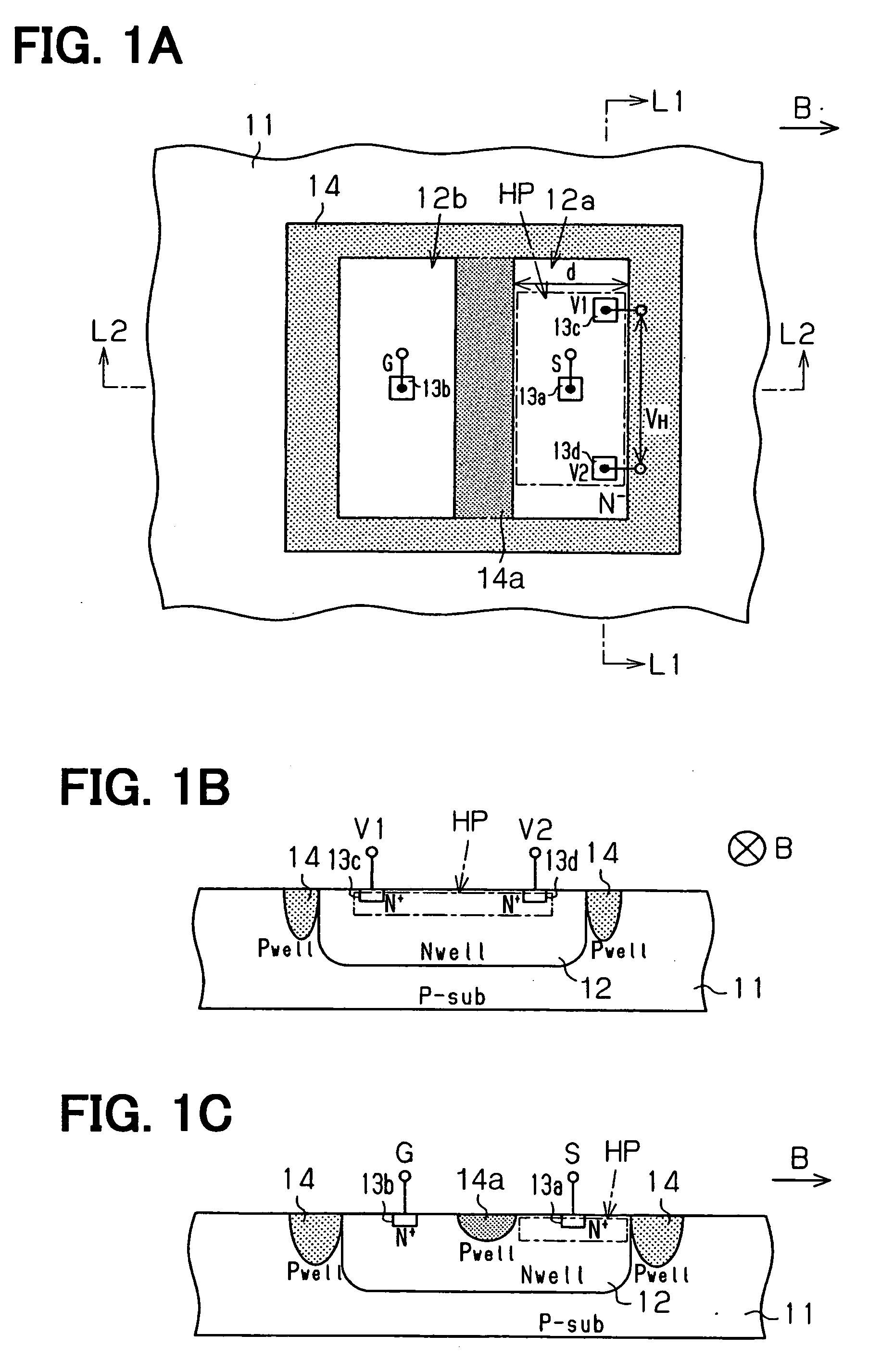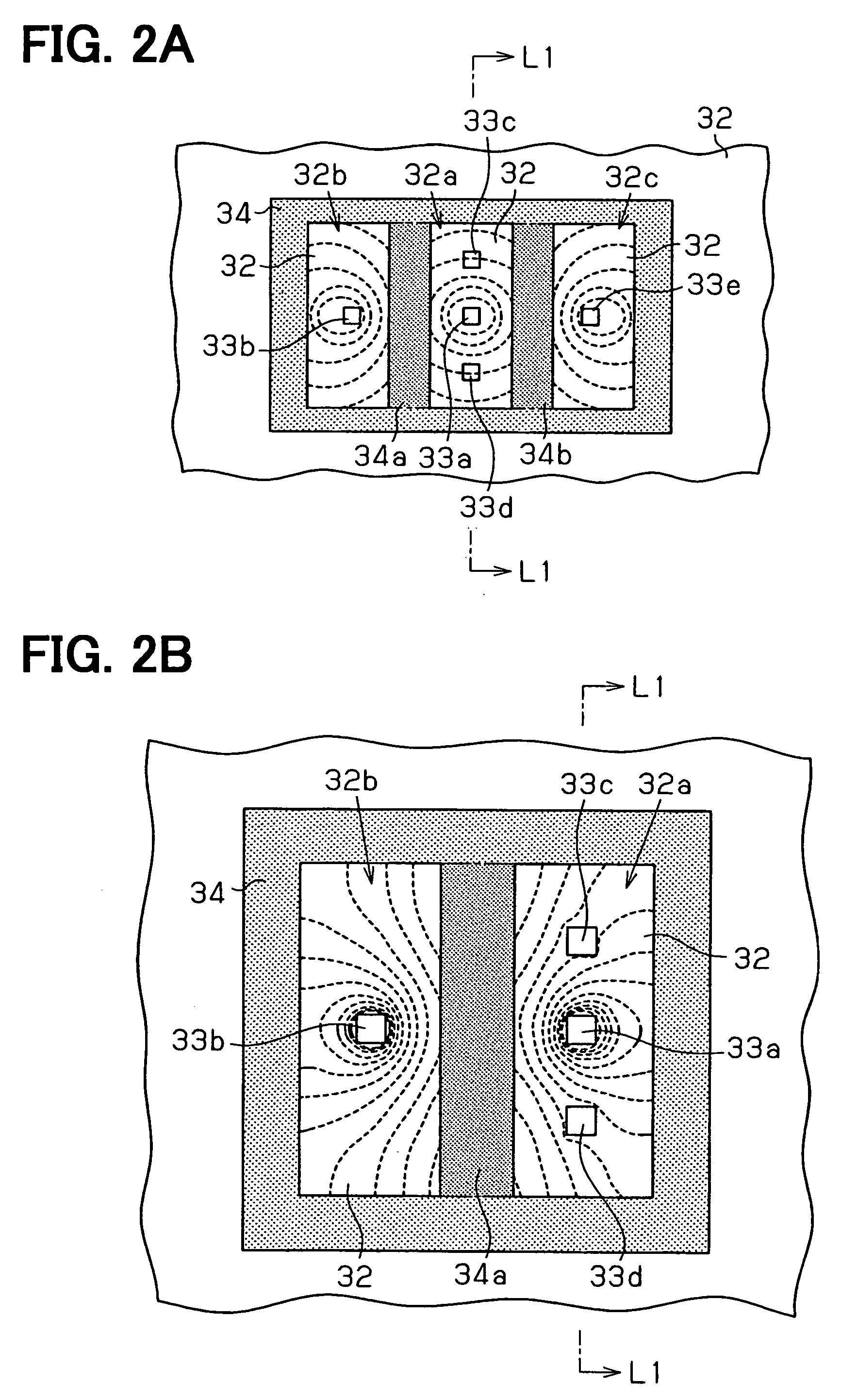Vertical Hall device and method for adjusting offset voltage of vertical Hall device
a vertical hall and offset voltage technology, applied in the direction of galvano-magnetic devices, galvano-magnetic hall-effect devices, instruments, etc., can solve the problems of unbalanced potential distribution within the element, unbalanced resistance bridge as an equivalent circuit of a resistance component within the element, and room for improvement, so as to achieve easy and accurate determination
- Summary
- Abstract
- Description
- Claims
- Application Information
AI Technical Summary
Benefits of technology
Problems solved by technology
Method used
Image
Examples
first embodiment
[0142] Hereinafter, a first embodiment of a vertical Hall element according to the invention is represented.
[0143] First, a schematic structure of the vertical Hall element according to the embodiment and an operation mode of the element are described with reference to FIG. 1A to FIG. 1C. In FIG. 1A to FIG. 1C, FIG. 1A is a plan view typically showing a planar structure of the Hall element, FIG. 1B is a cross section view along a line L1-L1 of FIG. 1A, and FIG. 1C is a cross section view along a line L2-L2 of FIG. 1A.
[0144] As shown in FIGS. 1A to 1C, the Hall element is roughly configured to have a semiconductor layer (i.e., P−sub) 11 comprising, for example, P-type silicon, and a N-type semiconductor region (i.e., N well) 12 formed as a diffusion layer (i.e., well), for example, by introducing an N-type conductivity type impurity into a surface of the layer 11. As described before, in the semiconductor material such as silicon, since N-type semiconductor has large carrier mobili...
second embodiment
[0170]FIG. 7 shows a second embodiment of a vertical Hall element according to the invention.
[0171] Hereinafter, a structure of the vertical Hall element according to the embodiment is described with reference to FIG. 7 mainly on different points from the previous first embodiment. A plan view of the FIG. 7 corresponds to the plan view of the previous FIG. 1A, and respective elements identical to the elements shown in the FIG. 1A are shown with being marked with identical signs, and overlapped description on the elements is omitted.
[0172] As shown in the FIG. 7, the vertical Hall element has the approximately same structure as the vertical Hall element of the previous first embodiment exemplified in FIG. 1A to FIG. 1C, in addition, an operation mode of the element is the same as the mode described before. That is, in the vertical Hall element, a structure is made, wherein in the periphery of the axis (line L1-L1) given by the contact regions 13c and 13d provided as the portions fo...
third embodiment
[0175]FIG. 8 shows a third embodiment of a vertical Hall element according to the invention.
[0176] Hereinafter, a structure of the vertical Hall element according to the embodiment is described with reference to FIG. 8 mainly on different points from the previous first embodiment. A plan view of FIG. 8 corresponds to the plan view of the previous FIG. 1A, and respective elements identical to the elements shown in FIG. 1A are shown with being marked with identical signs, and overlapped description on the elements is omitted.
[0177] As shown in the FIG. 8, the vertical Hall element has the approximately same structure as the vertical Hall element of the previous first embodiment exemplified in FIG. 1A to FIG. 1C, and an operation mode of the element is also the same as the mode described before. However, in the embodiment, a structure is made, wherein the diffusion layer 14 provided for isolating the relevant Hall element from other elements is omitted. Thus, simplification of the st...
PUM
 Login to View More
Login to View More Abstract
Description
Claims
Application Information
 Login to View More
Login to View More - R&D
- Intellectual Property
- Life Sciences
- Materials
- Tech Scout
- Unparalleled Data Quality
- Higher Quality Content
- 60% Fewer Hallucinations
Browse by: Latest US Patents, China's latest patents, Technical Efficacy Thesaurus, Application Domain, Technology Topic, Popular Technical Reports.
© 2025 PatSnap. All rights reserved.Legal|Privacy policy|Modern Slavery Act Transparency Statement|Sitemap|About US| Contact US: help@patsnap.com



